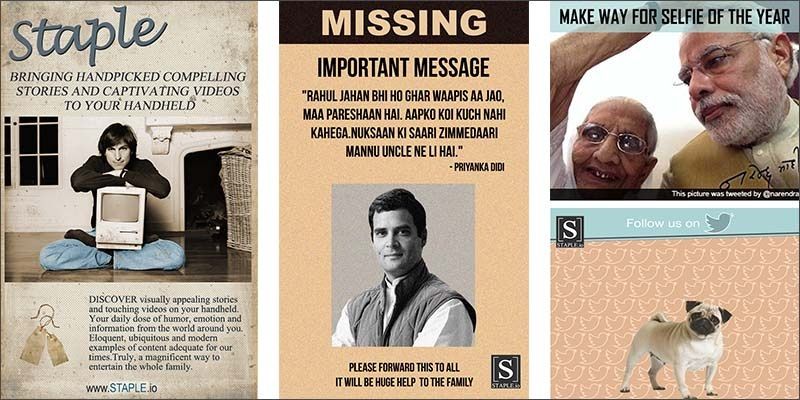Ex Jabong’s senior executives launch Indian Buzzfeed for mobile with Staple.io

Starting up is not easy, and for a few it takes a lot of deliberation across various ideas and opportunities before arriving at the ultimate one. “Over the past two years, I didn’t sleep a single night without mulling over ideas for my startup. Idea is like a bubble; at one moment it appears as the next billion dollar opportunity but another moment something else promises the same,” says Amit Singh, Founder and CEO of Staple.
You can loosely think of Staple.io as Indian Buzzfeed for mobile. It intends to be a platform for 'mobile first' 'user-generated' content. Till very recently, Amit was working as Director, Operations at Jabong.com. He is an alumnus of IIT Delhi and XLRI Jamshedpur, and has about a decade of experience, largely on the private equity and M&A side.
Why starting up?
“As I mentioned, I come from an investment background and always aspired to start on my own. Made some attempts which didn't materialize, possibly because I was an outsider in each industry I wanted to start in,” says Amit. His stint at Jabong exposed him to nuances of internet business. “Being a part of a startup like Jabong helped me learn about internet businesses. I along with my team worked hard to build JabongWorld.com from ground up. In parallel, I worked on some ideas, and finally Staple started taking shape and I decided to quit,” he adds.
The other Co-founder of Staple, Deepanshu also worked at Jabong. Being in the same team the duo used to bounce off startup ideas. “From what we were witnessing at Jabong and outside, we were completely sold out on the mobile story and thought of launching a mobile-based content platform,” he adds. Deepanshu is an IIT Kanpur and ISB Hyderabad alumnus.
Product’s positioning
Staple.io focuses on content which is designed keeping mobile screen and mobile usage patterns in mind. This means that content should fit into a single screen and consumption time per story has to be short. “In a way, we are trying to be the content equivalent of casual gaming. We are relying heavily on technology and analytics for content discovery. We are building the platform so that users are able to create/ transform/ repackage content on the go,” says Deepanshu.
The startup is live with its first version www.staple.io as well as Facebook app. Besides this, it is also testing soon-to-be launched Android app. “We have already started pushing content and plan to scale up the number of stories in the next few weeks,” says Amit.
Plans for scaling up
Distribution scale is the biggest challenge for most internet startups and Staple chooses to differentiate from noise by offering quality content. “That's our growth hack -- build a good product, enable discovery/ transformation/ creation of great content and tag along as the content gets distributed,” points out Amit.
Revenue model
“See, we are trying to build a business around a B2C product. In the internet world it's a 0-1 game, with odds against the entrepreneur. To be able to make money, we would need to have scale. If we have scale, then there are various ways to monetize,” adds Deepanshu. The company has built the sponsored stories/ tags and merchandising into the product itself and hopes to offer high engagement option to brands. “At present, most of the online marketing opportunities are transactional in nature; hopefully we would be able to pull the non-transactional (branding) dollars online,” he adds.
Size of opportunity
The duo feels that content industry is at a point of inflection. Youngsters have by-passed the newspapers and are quite selective on what they watch on television, restricting themselves largely to sports and youth channels. They get their entertainment, news and information from Facebook, Youtube and WhatsApp.
“Unfortunately, the quality of content in India is not good; till very recently there was little to choose from other than Bollywood and cricket. But things have started to change now. Youtube channels like TVF and AIB have demonstrated that if the content is good, people will watch,” says Amit.
Now as people move away from traditional channels like print and television, will the marketing dollars too? There is a huge white space there and an opportunity to build some large companies for entrepreneurs who get it right.











